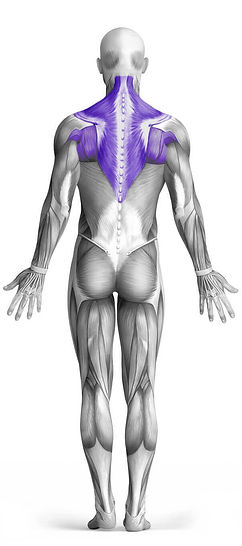Alternating Renegade Row 101 Video Tutorial
0

Exercise Synopsis
Target Muscle Group
Upper Back
Execution
Compound
Force Type
Pull
Required Equipment
Dumbbell
Fitness Level
Intermediate
Variations
Alternatives
None
Timer
Hour
Minute
Second
Stopwatch
00:00:00:00
Overview
The Alternating Renegade Row is a dynamic compound exercise that primarily targets the upper back muscles while also engaging secondary muscle groups including the lats, abs, biceps, chest, lower back, and shoulders. This exercise involves holding a pair of dumbbells in a plank position while alternating rows, pulling one dumbbell towards the hip while stabilizing the body with the other arm. It requires core stability, strength, and coordination to execute properly. By incorporating this exercise into a workout routine, individuals can effectively strengthen multiple muscle groups simultaneously, enhancing overall upper body strength and stability.
How to Perform
Begin by assuming a quadruped position, with your hands and knees on the ground, ensuring stability and alignment throughout your body.
Place two dumbbells directly beneath your shoulders, maintaining a neutral grip with your palms facing inward towards each other.
Initiate the movement by pulling one dumbbell towards your body, focusing on squeezing your shoulder blades together and keeping your elbow close to your torso.
Ensure that the elbow reaches (or slightly past) the midline of your body to maximize activation of the upper back muscles.
Lower the dumbbell back to the starting position in a controlled manner, maintaining stability and tension in your core throughout the movement.
Alternate sides and repeat the exercise for the desired number of repetitions, ensuring equal engagement of both sides of the upper back.
Throughout the exercise, maintain proper breathing patterns, inhaling during the eccentric phase (lowering the dumbbell) and exhaling during the concentric phase (pulling the dumbbell towards your body).
Focus on maintaining a strong and stable plank position throughout the exercise to effectively engage the secondary muscle groups, including the lats, abs, biceps, chest, lower back, and shoulders.
Gradually increase the weight of the dumbbells as your strength and proficiency improve, ensuring progressive overload for continued muscle growth and development.
As with any exercise, listen to your body and adjust the intensity and technique as needed to prevent injury and maximize results.
★ Bonus: For exercises that involve external weights (such as dumbbells, barbells, or machines), the One Rep Max (1RM) calculator can help you estimate your maximum lifting capacity. Use it to track your strength progress and adjust your training for optimal results.
Tips
Prioritize maintaining stability in the hips throughout the exercise to prevent excessive swiveling; envision balancing a cup of water on your lower back to help stabilize the pelvis.
Engage your core muscles to maintain tension and stability in the spine as you pull the dumbbell towards your body, preventing excessive arching of the back.
Focus on controlling the movement of the dumbbells at all times, avoiding reliance on momentum to dictate the pace and intensity of the exercise.
Maintain proper alignment of the head and neck, avoiding forward jutting motions that can strain the cervical spine.
Ensure that the shoulder blades move along the rib cage during the rowing motion, rather than being locked down; this facilitates proper engagement of the upper back muscles and prevents overreliance on the glenohumeral joint for movement.
How Not to Perform
Avoid arching your lower back excessively during the exercise, as this can strain the lumbar spine and detract from targeting the upper back muscles effectively.
Do not rush through the movement or use momentum to pull the dumbbell upwards, as this diminishes the effectiveness of the exercise and increases the risk of injury.
Refrain from rotating your torso excessively while rowing the dumbbell, as this can shift the focus away from the upper back and lead to strain in the shoulders and lower back.
Avoid holding your breath or breathing shallowly throughout the exercise; instead, maintain a steady breathing pattern to support muscle engagement and oxygenation.
Do not allow your hips to sag or rise excessively during the exercise; maintain a stable plank position to maximize engagement of the core muscles and prevent strain on the lower back.
Avoid gripping the dumbbell too tightly, as this can create unnecessary tension in the forearm and detract from focusing on the targeted muscle groups.
Do not neglect proper warm-up and stretching before performing the exercise, as this helps prepare the muscles for the movement and reduces the risk of injury.
Avoid excessively shrugging your shoulders towards your ears during the rowing motion; instead, focus on pulling the shoulder blades back and down to engage the upper back effectively.
Do not allow your head to droop or extend forward; maintain a neutral alignment with your spine to minimize strain on the neck and upper back muscles.
As with any exercise, listen to your body and stop immediately if you experience any pain or discomfort, adjusting your technique as needed to prevent injury and optimize results.
Variations
Variations of fitness exercises refer to different ways of performing a specific exercise or movement to target various muscle groups, intensities, or goals. These variations aim to challenge the body differently, prevent plateaus, and cater to individuals with varying fitness levels.
Alternatives
Alternative exercises in fitness refer to different movements or activities that target similar muscle groups or serve the same training purpose as the primary exercise. These alternative exercises can be used as substitutes when the original exercise is unavailable or challenging to perform due to various reasons such as equipment limitations, injuries, or personal preferences.








